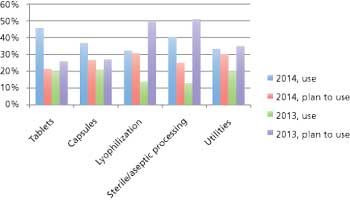Survey Shows Importance of Process Analytical Technology
Equipment and Processing Report
Pharmaceutical Technology’s survey collected industry feedback on trends and the utility of equipment used in finished drug-product manufacturing.
Pharmaceutical Technology’s annual equipment and manufacturing survey collected industry feedback on trends and the utility of equipment used in finished drug-product manufacturing. Respondents to both solid-dosage and parenteral drug manufacturing questions indicated overall satisfaction with existing equipment and equipment innovation. Data indicated that process analytical technology (PAT) is growing in use, but some users also noted a need for improvement in existing PAT equipment and in new solutions.
Solid-dosage equipment
Existing solid-dosage equipment is generally meeting industry needs. Only one area-PAT/in-process testing-was indicated as poor or inadequate by more than one-third of respondents (see Figure 1). Nearly one quarter of respondents also indicated that innovation is lacking in this area. This dissatisfaction is up from 2013, in which 22% indicated existing equipment was poor or inadequate and 16% said innovation was poor (1). It is interesting to note that use of PAT also increased over the past year among those surveyed. Process control/automation and powder transfer/materials handling were also flagged as needing significant improvement in existing equipment (25% and 21%, respectively) and in innovation (17% and 12%); these areas were also noted in 2013.

Parenteral equipment
The majority of parenteral-equipment respondents indicated that existing equipment is good or excellent, as shown in Figure 2. These respondents also agreed that innovation is generally keeping pace with most, if not all, of their needs. Innovation was rated as excellent or good in lyophilization (95%), barrier isolation (91%), disposables (91%), vial and cartridge fill-finish equipment (92%), and prefilled-syringe fill-finish equipment (85%). Process control and automation was a weaker area, similar to 2013, with approximately 25% saying that existing equipment is either poor or inadequate, and 18% saying that innovation is poor.

PAT
In the five manufacturing areas surveyed, the use of PAT increased significantly since 2013 (see Figure 3), with 32-46% of respondents in 2014 indicating that they currently use PAT compared to 13-21% of respondents in 2013 (1). The primary drivers for using PAT (multiple answers possible) include better process understanding (56%), increased efficiency (39%), reduced costs (34%), and shorter process times (30%). The use of PAT should continue to grow; between 20 and 30% of respondents in 2014 indicate plans to implement PAT in the coming year. Approximately one-third of respondents (33-37% depending on the application), however, do not currently use PAT and do not plan to implement it in the coming year.

Areas for innovation
Given these plans to implement PAT and the respondents who said that existing PAT tools do not meet their needs, as discussed previously, PAT is an area ripe for suppliers to develop new and improved instruments.
----
This article was excerpted from
"Trends in Manufacturing and Equipment"
in the July 2014 issue of
Pharmaceutical Technology
.
Read the full article
for the complete survey analysis, which includes responses to questions on quality by design, metrics, continuous manufacturing, and manufacturing of highly potent drugs.
Drug Solutions Podcast: A Closer Look at mRNA in Oncology and Vaccines
April 30th 2024In this episode fo the Drug Solutions Podcast, etherna’s vice-president of Technology and Innovation, Stefaan De Koker, discusses the merits and challenges of using mRNA as the foundation for therapeutics in oncology as well as for vaccines.
INTERPHEX 2025: Use of Walk-In Chambers for Bio/Pharma Development and Manufacturing
April 2nd 2025Sitting down with the PharmTech Group at INTERPHEX 2025, Christopher Murphy, director of Global Business Development and Service Customer Support at Environmental Specialties, discusses the design and critical role of walk-in chambers in the bio/pharmaceutical industry.